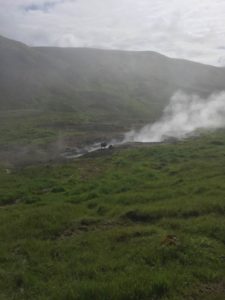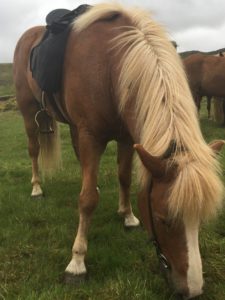“Some parts of Iceland look like Montana, some areas look like the moon. Most of Iceland looks like nowhere else on Earth. You will run out of superlatives to describe Iceland’s landscape when you return home.”
– #12 on the Casual Travelist’s 25 Tips You Should Know for your First Trip to Iceland

Skogafoss

Sheep about to fall into Middle Earth…
Fresh back from a trip to mystical, moody Iceland, and I finally found a place with more “weather drama” than Montana. I’ve been obsessed with Iceland and Icelandic horses for a long time, and this trip was years in the making. We explored the dark Viking history of Reykjavik, skirted behind a thundering waterfall, gazed upon the infamous Eyjafjallajökull volcano ice cap, logged full days in the saddle, and resorted to eye masks for sleeping (thanks to 24/7 daylight).
 One of the reasons Iceland has long entranced me is the huge role horses play in its fascinating history. As we tölted through the lush green (read: soggy) countryside, I pondered the history between horses and humans. It really wasn’t that long ago that people relied on horses for life’s essentials (e.g. transportation, farm labor). Yet, nowadays many people will go their entire lives without putting a single foot in the stirrup (why anyone would abstain from riding, I don’t know!).
One of the reasons Iceland has long entranced me is the huge role horses play in its fascinating history. As we tölted through the lush green (read: soggy) countryside, I pondered the history between horses and humans. It really wasn’t that long ago that people relied on horses for life’s essentials (e.g. transportation, farm labor). Yet, nowadays many people will go their entire lives without putting a single foot in the stirrup (why anyone would abstain from riding, I don’t know!).
Icelanders are very proud of their horses and for good reason. Here’s a quick 101, from the book Iceland: Land of the Sagas:
Compared to horses elsewhere, the Icelandic breed is small, thin-legged, full-maned, graceful, and docile…Driving across the country, you will see horses moving in the tölt, or fifth gait, an odd running walk so smooth the rider’s head does not bob; no other horse in the world still accomplishes this gait, which has been lost in Europe due to breeding.
The Icelandic horse has an even purer pedigree than the Icelander himself. For more than eight hundred years, no horses have been imported into the country. A horse may be sold abroad, but once it has left Iceland, it can never return.
I may not have Viking blood in my veins, but there’s nothing like horses and nature to spark a new understanding of the interconnectedness of us all, across time and space. When we halted our horses at our first breathtaking view of Lake Þingvellir, I felt a profound connection to the past and the people and horses who first witnessed such raw beauty.

Fire and Ice. Vikings. The Sagas, a tour de force of medieval literature that never made it to the required reading list, why I don’t know. Midnight Sun.
Iceland spoke to my soul in many ways, but none more than feeling that magical horse-human connection so alive and well, firmly rooted in the local psyche. Never have I visited a place where almost everywhere you turn, you feel such equine presence and reverence. It seeped into my soul. And after soaking up every experience on this enchanting island, full of the Viking spirit and the spirit of the small-yet-mighty Icelandic Horse, I headed home in renewed awe of the horse-human connection. It’s something we’ve always discussed on our retreats, but I’ll do so with even more conviction and wonder now.
It’s impossible not to fall under Iceland’s spell. After months trying to extract the same level of anticipation I felt from my tween daughter, it was magical to watch her become more spellbound by the day, the hour, the mile. Before we even landed back on U.S. soil, she asked when we could return.
And I’m sure we will. But, for now, I’m focused on reconnecting with my own herd in a whole new way. I’m focused on seeing my own horses for the majestic, selfless partners they are today — and have been for centuries. Our histories are interwoven, and I’ve never been so grateful for this infinite connection.
P.S. If Iceland has been calling to you, too, go. Trust me. Just go. And check out our amazing friends Eldhestar. They’re gracious hosts, Icelandic Horse devotees, and committed to offering an authentic Iceland experience.